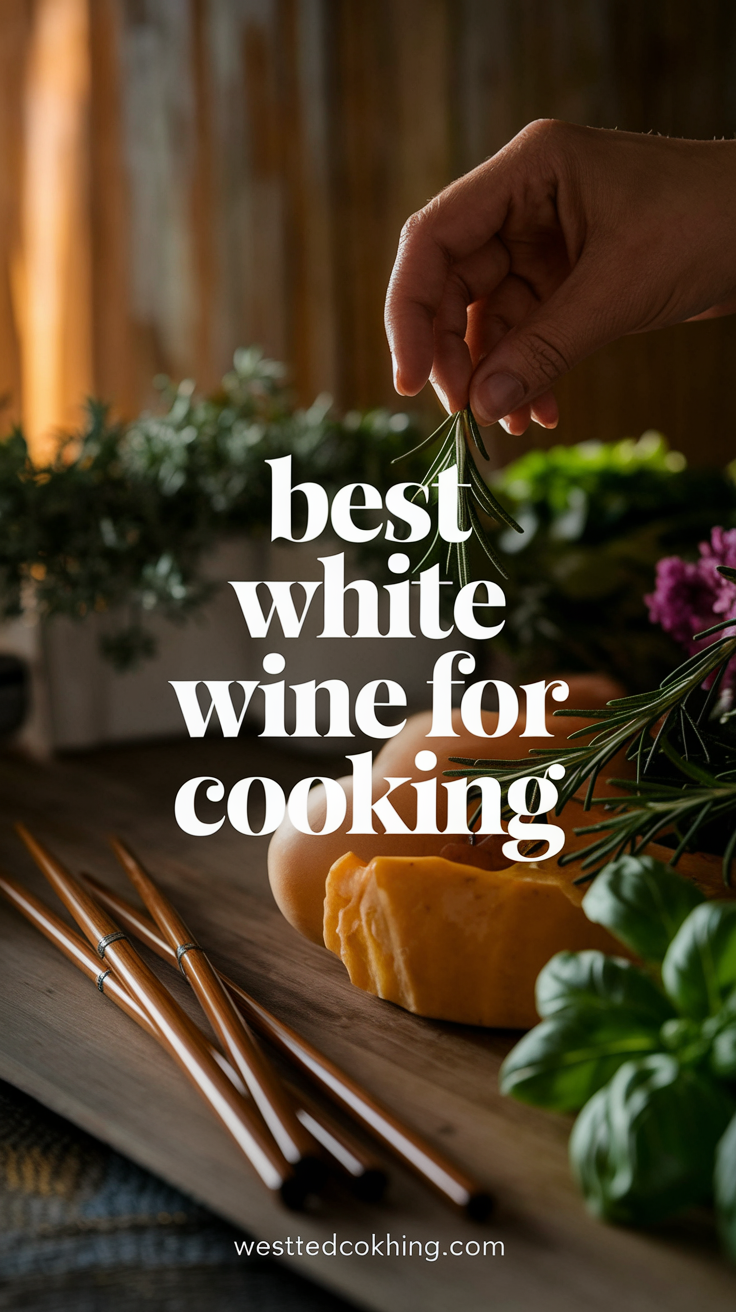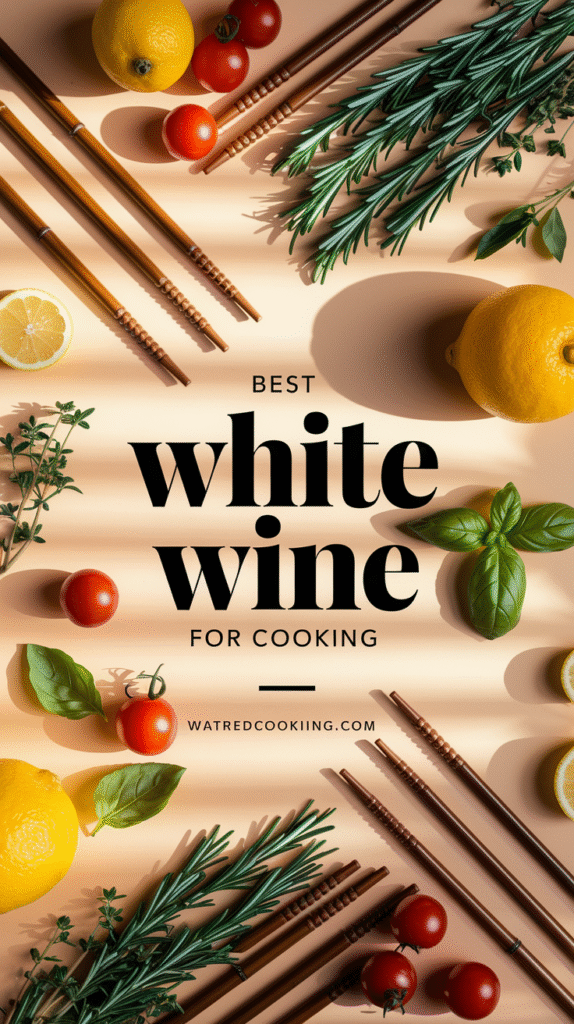When it comes to enhancing the flavor of your dishes, choosing the right white wine for cooking is crucial. Not all wines are created equal; the variety you select can significantly influence the taste of your meal. Understanding the flavor profiles of different white wines and matching them with your dish will elevate your culinary experience.
Generally, the best white wines for cooking fall into a few categories based on their flavor profiles: dry, fruity, and acidic. Here’s a closer look at some recommended options.
Dry White Wines
Dry white wines are a popular choice for savory dishes because they add depth without overpowering the other ingredients. Here are a few notable options:
- Sauvignon Blanc: This wine is crisp with notes of green apple, citrus, and herbs. It works wonderfully for seafood dishes, chicken, and recipes that feature vibrant vegetables.
- Pinot Grigio: Known for its light and zesty personality, Pinot Grigio can enhance pasta dishes and light sauces, making it an excellent choice for cooking with cream.
- Chardonnay: This versatile wine has flavors that can range from buttery to fruity, depending on how it’s aged. Oaked Chardonnay is perfect for richer dishes like creamy risottos, while unoaked Chardonnay is suited for grilled meats.
Fruity White Wines
If you’re looking to add a touch of sweetness without being overbearing, fruity white wines are a great option. These wines can add an appealing layer of flavor to various dishes:
- Moscato: Its sweet and fruity profile is perfect for glazes, particularly in dishes that feature pork or chicken.
- Riesling: Often used in Asian cooking, Riesling brings a unique balance of acidity and sweetness that complements spicy dishes beautifully.
Acidic White Wines
Acidic wines can boost the flavors of your dishes, balancing out rich or heavy ingredients. Look for these wines:
- Verdelho: This lesser-known wine is quite acidic and fruity, ideal for use in marinades or dressings.
- Vinho Verde: Light and refreshing, this Portuguese wine can enhance your seafood dishes while adding zest.
Choosing the Right White Wine for Pairing
Matching your wine to the right meal is essential for achieving the best flavor outcomes. Here’s a simple guide:
| Dish | Best White Wine Pairing |
|---|---|
| Seafood | Sauvignon Blanc or Pinot Grigio |
| Pasta (light sauce) | Chardonnay or Pinot Grigio |
| Chicken | Chardonnay or Riesling |
| Pork | Moscato or Riesling |
| Vegetable Dishes | Sauvignon Blanc |
Not only should you consider the flavor profile of the wine, but also how it interacts with your dish’s ingredients. Cooking with wine should enhance the overall taste, so it’s essential to experiment and find what works best for you.
As a rule of thumb, avoid using wines that you wouldn’t drink because poor-quality wines can produce off-flavors. Stick to wines labeled as dry or off-dry, labeled specifically for cooking or suitable for pairing.
For further reading and product recommendations, consider checking out [Wine Folly](https://winefolly.com/) and [The Kitchn](https://www.thekitchn.com/). They provide excellent insights into wine selections and cooking tips. You can also explore more at [Wine Enthusiast](https://www.winemag.com/) for expert advice and beverage pairings.
Now that you know about the best white wines for cooking, go ahead and unleash your culinary creativity! Including the right wine can truly transform your dish, making every bite an unforgettable experience.
Understanding the Role of Wine in Culinary Techniques
Wine plays a significant role in culinary techniques, serving not only as a beloved beverage but also as a crucial ingredient in many recipes. Understanding how to incorporate wine into cooking can elevate your dishes, adding depth, flavor, and complexity. Different types of wine can enhance various cuisines and cooking methods, offering unique benefits to your meal preparations.
When it comes to cooking, white wine is often preferred for its lighter taste and versatility. It complements a variety of ingredients, making it an ideal choice for sauces, marinades, and sautéing. Choosing the best white wine for cooking can make a noticeable difference in the final dish. Here are some types of white wines commonly used in culinary techniques:
- Sauvignon Blanc: This wine is crisp and refreshing, making it perfect for seafood dishes, salads, and light pasta sauces. Its high acidity balances rich flavors, providing a nice contrast that enhances the overall taste.
- Chardonnay: Available in both oaked and unoaked varieties, Chardonnay adds buttery flavors that work well in creamy sauces and risottos. The oaked version can introduce notes of vanilla and spice, enriching dishes like pan-seared chicken or lobster.
- Pinot Grigio: Known for its light and zesty profile, this wine pairs beautifully with grilled vegetables and light meats. It’s also excellent in vinaigrettes.
- Vermouth: This fortified wine is a great choice for creating sauces and marinades. It adds a unique herbal and floral dimension to your dishes.
- Dry Riesling: With its crispness and hint of sweetness, dry Riesling pairs well with spicy dishes, enhancing the flavors without overwhelming them.
When using wine in cooking, the process can be broken down into several techniques. Each method highlights different aspects of the wine’s flavor, contributing to the dish’s overall profile:
- Deglazing: After sautéing meat or vegetables, a splash of wine can help lift the bits stuck to the pan, creating a rich base for sauces. This technique captures flavors that would otherwise be lost.
- Marinating: Soaking proteins in a mixture that includes wine can infuse them with flavors. The acid in the wine tenderizes the meat, making it more succulent.
- Simmering: Adding wine to stews and braises not only flavors the dish but also helps to tenderize tougher cuts of meat. The alcohol evaporates during cooking, leaving a depth of flavor behind.
- Sous Vide Cooking: The precision of sous vide allows wine to infuse flavors thoroughly. wine into the vacuum-sealed bag enhances the overall taste of the dish.
While pairing wine with food is common, the reverse can also be beneficial. The type of wine used can influence the flavors and textures of the food itself. Moreover, it is essential to choose a wine that you enjoy drinking for cooking since the taste will concentrate as the wine reduces.
When selecting wines, consider the region and grapes. For instance, wines from Tuscany often pair well with Italian dishes, while French white wines can enhance French cuisine. To streamline your choices, here’s a quick reference table you can follow:
| Type of Dish | Best Wine Pairing |
|---|---|
| Seafood | Sauvignon Blanc |
| Pasta with Cream Sauce | Chardonnay |
| Asian Cuisine | Dry Riesling |
| Grilled Chicken | Pinot Grigio |
It’s worth noting that inexpensive wines are perfectly fine for cooking. The key is to avoid overly sweet or low-quality wines that might spoil the dish. Opt for bottles labeled as “cooking wine” only if they are low in salt and suitable for drinking. Good quality white wines used in moderation can enhance both the aromatic and flavor profiles of many recipes.
As you delve into the world of culinary wine, don’t hesitate to experiment with different varietals and techniques. Each cooking style offers a fresh journey with wine, allowing you to discover the ideal pairings for your palate. For more tips on incorporating wine into your cooking, visit reputable culinary websites like Serious Eats and Food & Wine for insights and recipes.
How to Choose the Right Wine for Different Dishes
Choosing the right wine for different dishes can enhance the flavors of both the food and the wine. Whether you’re cooking a sumptuous meal at home or planning a dinner party, understanding how to pair wine with your dishes is key to creating an unforgettable dining experience. Here’s a guide to help you make the right choice.
Understanding the Basics of Wine Pairing
Wine pairing largely depends on the flavors present in both the wine and the dish. Some general rules can help guide your decisions:
- Complement or Contrast: You can either complement a dish’s flavors with a similar wine or contrast it to create balance.
- Consider Acidity: Higher acidity wines pair well with acidic dishes, like those containing tomatoes or citrus.
- Match Intensity: Light dishes pair best with lighter wines, while rich, hearty dishes require more robust wines.
Pairing Wine with Common Dishes
Here’s a simple guide to help you choose the right wine for various types of dishes:
| Dishes | Recommended Wines |
|---|---|
| Chicken Dishes | Chardonnay or Sauvignon Blanc |
| Seafood | Pinot Grigio or Albariño |
| Pasta with Tomato Sauce | Chianti or Merlot |
| Grilled Vegetables | Sauvignon Blanc or Rosé |
| Red Meat | Cabernet Sauvignon or Syrah |
| Desserts | Moscato or Port |
The Role of White Wine in Cooking
When it comes to cooking, white wine can brighten up dishes, adding depth and acidity. Here are some pointers on how to select the best white wine for cooking:
- Use Dry over Sweet: Dry white wines, like Sauvignon Blanc or Pinot Grigio, are ideal for cooking. Sweet wines can make a dish overly sugary.
- Avoid Cooking Wines: Cooking wines often contain added salt and preservatives, which can affect the dish’s taste. It’s better to use a drinkable wine.
- Consider the Flavors: Light, crisp wines enhance lighter dishes, while fuller-bodied wines pair well with rich ingredients and sauces.
Tips for Selecting the Right Wine
When in doubt, consider the following tips:
- Choose Local: Local wines often pair exceptionally well with local cuisine.
- Ask for Recommendations: Wine shop staff are typically knowledgeable and can guide you based on your specific dish.
- Experiment: Don’t be afraid to try new pairings. You might discover uncommon combinations that delight your palate.
Where to Learn More
If you want to dive deeper into the world of wine and food pairings, consider visiting [Wine Folly](https://winefolly.com/) or [Wine Pairing](https://www.winepairing.com/) for great resources and guides.
Selecting the right wine for your dishes does not have to be daunting. By following these guidelines and using the suggested pairings, you can enhance your meals and impress your guests. Remember, the best wine is one that you enjoy, so trust your palate and have fun with the experience!
Cooking with White Wine: Enhancing Sauces and Marinades
Cooking with white wine is a time-honored technique that can elevate your recipes, adding depth and complexity to your dishes. Whether you’re simmering a sauce or marinating chicken, the right white wine can transform an ordinary meal into an extraordinary one. This article dives into how to effectively incorporate white wine, particularly focusing on enhancing sauces and marinades.
When selecting the best white wine for cooking, you want to consider a few important factors. Here are some of the most popular types of white wine that work incredibly well in the kitchen:
- Sauvignon Blanc: This wine is crisp and acidic, perfect for deglazing pans or adding brightness to marinades.
- Chardonnay: A full-bodied option, Chardonnay adds a rich flavor to creamy sauces and braises.
- Pinot Grigio: Light and refreshing, this wine is ideal for seafood dishes and delicate sauces.
- Riesling: A slightly sweeter option that adds a unique dimension, especially to spicy dishes.
Using white wine in sauces can enhance flavors in various ways. For example, when sautéing vegetables or proteins, adding a splash of white wine can help to deglaze the pan, lifting the delicious browned bits left behind. This not only adds flavor but also contributes to a lovely sauce. Just be sure to let the wine cook down to concentrate the flavors—allow it to simmer until the liquid reduces by half, which will also cook off any alcohol content.
One of the most popular sauces that benefit from white wine is the classic white wine reduction sauce. Here’s how you can create this elegant, flavorful sauce at home:
- Ingredients:
- 1 cup of white wine (Sauvignon Blanc works well)
- 2 tablespoons of butter
- 1 shallot, finely chopped
- Salt and pepper to taste
- Fresh herbs (like parsley or thyme) for garnish
- Instructions:
- In a saucepan, melt the butter over medium heat.
- Add the chopped shallots and sauté until translucent.
- Pour in the white wine and bring it to a gentle boil.
- Let the mixture simmer, reducing by half to concentrate the flavors.
- Season with salt and pepper, and finish with fresh herbs before serving.
Marinades are another fantastic way to use white wine. They help tenderize meat and infuse it with flavor. A simple marinade can make a world of difference. For example, when marinating chicken, combine white wine with olive oil, garlic, lemon juice, and herbs. The wine adds a layer of acidity that helps to penetrate the meat, resulting in a juicier and more flavorful final dish.
Here’s a simple chicken marinade recipe:
- Ingredients:
- 1 cup of white wine (like Pinot Grigio)
- 1/4 cup of olive oil
- Juice of 1 lemon
- 3 cloves of garlic, minced
- Salt and pepper to taste
- Fresh herbs (such as rosemary or thyme)
- Instructions:
- Mix all ingredients in a bowl.
- Place the chicken in a resealable plastic bag and pour the marinade over it.
- Seal the bag, ensuring the chicken is well coated, and refrigerate for at least 1 hour (or overnight for best results).
Remember that not all wines are created equal. Make sure to choose a good quality white wine that you would enjoy drinking. The flavors will concentrate in your dishes, so it’s worth investing in something decent. For more information on choosing the best wine, check out Wine Enthusiast or Food & Wine.
Using white wine in cooking opens up a world of flavor possibilities. Whether in sauces or marinades, it adds acidity, sweetness, and complexity. So next time you head to the kitchen, remember to grab a bottle of white wine—it may just be the secret ingredient that transforms your cooking! Enjoy experimenting and discovering your own favorite combinations!
Popular White Wine Varieties and Their Cooking Applications
Cooking with white wine can elevate the flavors of your dishes. Different varieties of white wine possess unique characteristics that make them suitable for various cooking applications. Here’s a look at some popular white wine varieties and how you can use them effectively in your culinary endeavors.
Chardonnay
Chardonnay is one of the most versatile white wines, making it a favorite for cooking. Its creamy texture and rich flavors can enhance dishes significantly.
- Cooking Applications:
- Pair with creamy sauces for pasta or chicken.
- Use in risottos for added depth.
- Perfect for braising meats or vegetables.
Chardonnay can range from oaky to fruity, so choose a style that complements your dish. Try using a good quality Chardonnay for optimal flavor.
Sauvignon Blanc
Renowned for its crispness and herbal notes, Sauvignon Blanc adds brightness to dishes. It’s a great choice for recipes requiring a fresh, zesty flavor.
- Cooking Applications:
- Ideal for seafood dishes, like fish or shrimp scampi.
- Add to marinades for chicken or pork.
- Enhance vegetable dishes like asparagus or peas.
A high-quality Sauvignon Blanc can also work well in salad dressings for a zing. Discover more about this wine on MasterClass.
Pinot Grigio
Pinot Grigio is a light and crisp wine that is often characterized by its bright acidity and floral aromas. It serves well in a variety of cooking methods and brings out fresh flavors.
- Cooking Applications:
- Perfect for sautéing vegetables.
- Use in light sauces, especially those with citrus.
- Add to stews or soups for a refreshing finish.
This varietal works beautifully with pasta dishes as well. For more insights on cooking with Pinot Grigio, visit Food Network.
Riesling
Riesling is known for its sweet and fruity profile, making it an interesting choice for culinary uses. When you want to add a layer of sweetness to your dish, Riesling can be a delightful option.
- Cooking Applications:
- Use in glazes for meats, especially pork and chicken.
- Great for desserts or sauces that require a hint of sweetness.
- Ideal in stir-fries for adding a sweet and tangy flavor.
Riesling complements fruit-based sauces well. Check out more cooking tips with Riesling at Wine Enthusiast.
Dry Vermouth
While not a traditional wine, dry vermouth is a fortified wine that can add a complex layer of flavor to your culinary creations. It offers herbal notes and sweetness that can enhance various dishes.
- Cooking Applications:
- Perfect for deglazing pans after searing meat.
- Use in marinades for added herbaceous flavor.
- Great in sauces that accompany fish or chicken.
A little dry vermouth goes a long way in enriching flavors. Learn more about dry vermouth uses on Serious Eats.
| Wine Variety | Flavor Profile | Best Uses |
|---|---|---|
| Chardonnay | Rich, creamy | Sauces, braising |
| Sauvignon Blanc | Crisp, herbal | Seafood, marinades |
| Pinot Grigio | Light, floral | Vegetables, light sauces |
| Riesling | Fruity, sweet | Glazes, desserts |
| Dry Vermouth | Herbal, complex | Deglazing, marinades |
These white wine varieties into your cooking can enhance the flavors of your meals remarkably. Whether you are preparing a simple dish or an elaborate feast, the right white wine can make all the difference in achieving a delightful culinary experience.
Conclusion
Choosing the best white wine for cooking can significantly elevate your culinary creations. Each variety, from crisp Sauvignon Blanc to rich Chardonnay, brings its unique flavor profile to the table, enhancing everything from sauces to marinades. Understanding the role of wine in cooking allows you to maximize its potential, transforming simple dishes into extraordinary meals through the right wine pairing.
When selecting a wine, consider the specific flavors and ingredients in your dish. A dry Riesling can add a touch of sweetness, whereas a Pinot Grigio can brighten up a seafood dish with its acidity. Familiarizing yourself with popular white wine varieties and their ideal uses in the kitchen will empower you to make informed choices that harmonize with your ingredients.
Cooking with white wine is not just about adding liquid but rather about infusing depth and complexity into your flavors. Whether you’re deglazing a pan or marinating meats, the right white wine can enhance your dish in remarkable ways. By learning how to pick the appropriate wine for different culinary techniques and flavors, you can transform everyday recipes into stunning masterpieces.
With so many options available, experimenting and finding the best white wine for cooking will increase your confidence in the kitchen. Embrace the art of cooking with wine, and let your meals reflect the rich flavors and aromas that a delightful white can offer. Happy cooking!







Leave a Reply